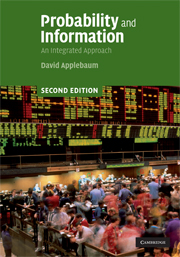Book contents
- Frontmatter
- Contents
- Preface to the second edition
- Preface to the first edition
- 1 Introduction
- 2 Combinatorics
- 3 Sets and measures
- 4 Probability
- 5 Discrete random variables
- 6 Information and entropy
- 7 Communication
- 8 Random variables with probability density functions
- 9 Random vectors
- 10 Markov chains and their entropy
- Exploring further
- Appendix 1 Proof by mathematical induction
- Appendix 2 Lagrange multipliers
- Appendix 3 Integration of exp(−½x2)
- Appendix 4 Table of probabilities associated with the standard normal distribution
- Appendix 5 A rapid review of matrix algebra
- Selected solutions
- Index
8 - Random variables with probability density functions
Published online by Cambridge University Press: 06 July 2010
- Frontmatter
- Contents
- Preface to the second edition
- Preface to the first edition
- 1 Introduction
- 2 Combinatorics
- 3 Sets and measures
- 4 Probability
- 5 Discrete random variables
- 6 Information and entropy
- 7 Communication
- 8 Random variables with probability density functions
- 9 Random vectors
- 10 Markov chains and their entropy
- Exploring further
- Appendix 1 Proof by mathematical induction
- Appendix 2 Lagrange multipliers
- Appendix 3 Integration of exp(−½x2)
- Appendix 4 Table of probabilities associated with the standard normal distribution
- Appendix 5 A rapid review of matrix algebra
- Selected solutions
- Index
Summary
Random variables with continuous ranges
Since Chapter 5, we have been concerned only with discrete random variables and their applications, that is random variables taking values in sets where the number of elements is either finite or ∞. In this chapter, we will extend the concept of random variables to the ‘continuous’ case wherein values are taken in ℝ or some interval of ℝ.
Historically, much of the motivation for the development of ideas about such random variables came from the theory of errors in making measurements. For example, suppose that you want to measure your height. One approach would be to take a long ruler or tape measure and make the measurement directly. Suppose that we get a reading of 5.7 feet. If we are honest, we might argue that this result is unlikely to be very precise – tape measures are notoriously inaccurate and it is very difficult to stand completely still when you are being measured.
To allow for the uncertainty as to our true height we introduce a random variable X to represent our height, and indicate our hesitancy in trusting the tape measure by assigning a number close to 1 to the probability P(X ∈ (5.6, 5.8)), that is we say that our height is between 5.6 feet and 5.8 feet with very high probability. Of course, by using better measuring instruments, we may be able to assign high probabilities for X lying in smaller and smaller intervals, for example (5.645, 5.665); however, since the precise location of any real number requires us to know an infinite decimal expansion, it seems that we cannot assign probabilities of the form P(X = 5.67).
- Type
- Chapter
- Information
- Probability and InformationAn Integrated Approach, pp. 155 - 187Publisher: Cambridge University PressPrint publication year: 2008



